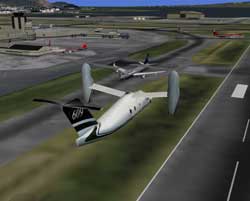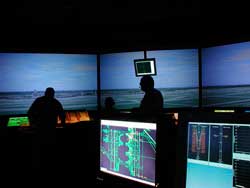 |
|
| |
|
|
|
|
|
+ Home |
|
| |
||
| |
||
| |
|
|
| |
|
|
||||||||||||||||||||||||||||||||||||||||||||||
| Overview NASA and the FAA are working together to revolutionize air traffic management for the National Airspace System (NAS). Ames' Simulation Laboratories (SimLabs) are playing a significant role in this endeavor through the (VAMS) Project. This project is part of the NASA Airspace Systems Program being conducted in cooperation with the Federal Aviation Administration. NASA's concept for a new air transportation system envisions large increases in the movement of people and cargo, including all kinds of vehicles, both manned and unmanned, small aircraft, and reusable launch vehicles. Revolutionary concepts will need to be rigorously tested in order to select the most beneficial. For this purpose, the Virtual Airspace Simulation Technologies (VAST) Project, one cornerstone of the VAMS project, is charged with providing the means for testing the new concepts through advancements in simulation and modeling. Real time simulation will ensure that human performance and human factors studies can be performed in order to better understand human and system interactions. To this end, a series of tests will be conducted, demonstrating connectivity among Ames simulation facilities. Beginning in November 2002 and concluding in the Fall of 2004 each test will showcase, verify and validate the VAST-RT progress. FutureFlight Central will play a part in several of these tests.
+ Back to Top Interim Test #1: Interim Test #1 was conducted in November of 2002. The primary purpose was to demonstrate distributed data communications using High Level Architecture (HLA) between the B747, the Advanced Concepts Flight Simulator (ACFS), and the ATC simulators and verify and validate the operation of the new VAST-RT communications scheme. Validation included visual presentation from each flight simulator to the other flight simulator’s visual system and correct target tracking by all ATC displays. Network usage was also measured during the test. Function tests were conducted on bandwidth, compatibility, alignment, and reliability. The system performed acceptably in all tests. + Back to Top Interim Test #2: Interim Test #2 was conducted January 21-24, 2003. The primary purpose was to establish connectivity between the FutureFlight Central tower simulator and the B747-400 flight simulator through the use of the HLA bridging technique. In Interim Test #2, FutureFlight Central and the Crew-Vehicle System Research Facility (CVSRF) aligned their Dallas/Fort Worth visual databases so that aircraft appeared at the same location in both the tower and the cockpit visual systems. Using the HLA interface, data such as call signs, altitude and speed, for each aircraft in the visual scene, was successfully passed back and forth between the two facilities. In the FutureFlight tower, the B747-400 appeared as one of the aircraft in the out-of-the-window tower visual scene and on the radar displays. On the CVSRF side, FutureFlight aircraft flying into and out of DFW appeared in the pilot's screens. Function tests were conducted on bandwidth, compatibility, alignment, and reliability. The system performed acceptably in all tests. + Back to Top Interim Test #3:
Interim Test #3 was conducted April 28-May 2, 2003. The primary purpose was to expand the capabilities to include the connectivity of the additional third facility in the Vertical Motion Simulator Complex (VMSC). In addition to the FutureFlight Central tower, the VMSC used a Civil Tiltrotor (CTR) simulation in a fixed base laboratory, and the CVSRF used the B747 simulator. In the test, the three facilities aligned their San Francisco International Airport visual database. The B747 and the CTR parked and taxied in close proximity to allow the pilot from each of the aircraft to view the other aircraft on the ground. The B747 and the CTR also flew in a pattern to allow the pilot from each of the aircraft to view the other aircraft in the air. The B747 and CTR pilots were able to view the FFC-generated aircraft targets on the ground and in the air. The air traffic controllers at FFC were also able to view these aircraft in the out-of-window views and radar along with the FFC-generated aircraft. Function tests were conducted on bandwidth, compatibility, alignment, data collection and reliability. The system performed acceptably in all tests. + Back to Top Interim Test #4: Interim Test #4 was conducted in August of 2003. The primary purpose was to deploy the first version of the Airspace Traffic Generator (ATG) and to use the ATG to demonstrate transfer of HLA object ownership between distributed simulation components. In addition, the VAST-RT FOM was used for the first time. For this interim test, two copies of the ATG application controlled aircraft and handed off ownership of the HLA object between the two target generators. A separate radar display was used to monitor all of the aircraft in the simulation, independent of the target generator that created it. Function tests were conducted on bandwidth, compatibility, alignment, and reliability. The system performed acceptably in all tests. + Back to Top Interim Test #5: Interim Test #5 was conducted on February 10-11, 2004. The primary purpose was to test the ability to transfer control of virtual aircraft from one simulation to another within a joint exercise. The Dallas/Fort Worth (DFW) Airport database was used for the simulation. The transfer of control mechanism was managed by an external system that monitors the position and behavior of aircraft. This mechanism passes a virtual aircraft from one simulator to another based on rules that can be configured. During the first 40-minute simulation, an external traffic generator simulated 44 arrivals to DFW. FFC pseudo pilots took control of all of the arrivals at 15 nautical miles from DFW and landed each flight on the appropriate runway. At the same time interspersed with the arrivals, FFC experienced 24 over-flights and departed 20 flights. Control of all of departures was successfully handed off to the external system. In a second test, the traffic level was increased to simulate airport capacity in the future. The purpose was to load test the simulation systems. Approximately 195 aircraft were simulated in this test (61 arrivals, 24 over-flights, 60 departures and 50 aircraft parked or staged throughout the airport.) In addition, a preliminary Graphical User Interface (GUI) was developed for researchers to observe ground and airborne traffic on a 2-D plan view display. This application provided centralized access to the traffic data within the other simulators in near real-time. As in previous interim tests, function tests were performed on bandwidth, compatibility, alignment, data collection and reliability. In addition, speed and positional continuity across the handoff was tested. The system performed acceptably in most tests. Some discrepancies were observed under the second high volume load test and are currently being addressed. + Back to Top Interim Test #6: Interim Test #6 was conducted on May 10-11, 2004. New SimLabs capabilities tested included incorporating a high fidelity in-route airspace simulator (Ames’ Airspace Operation Lab (AOL)) in the simulation, and demonstrating gate-to-gate simulation between the Dallas/Fort Worth International Airport (DFW) and the Chicago O’Hare International Airport (ORD). The simulated airspace covered all the ATC domains between DFW and ORD, including Tower, TRACON, and Center airspace. FutureFlight Central’s tower simulator represented DFW airport, and the AOL simulated portions of DFW TRACON, and the Kansas City Center. VAST components simulated all the other Center airspace and ORD. Controllers and pseudo-pilots staffed FFC and the AOL. Pseudo-pilots transferred control of virtual aircraft between DFW airport, the TRACONs and Center domains. DFW generated 20 aircraft departures that were handed off to the TRACON and received 44 arrivals. The DFW TRACON handled the 20 departures, plus 16 transfers from surrounding airspace, and 18 internally generated over-flights. The VAST-controlled airspaces managed a combined total of 54 aircraft transitioning between the different domains. In addition to these simulators, the Advanced Concept Flight Simulator (ACFS), as an American Airlines Boeing 757 aircraft, flew through the simulated airspace. The FFC, AOL and VAST system monitored the positions and behavior of the ACFS. The pilot was able to see, in its cockpit visual system, the virtual aircraft generated by the other simulators. The entire exercise in the DFW area ran for 1.5 hours. A gate-to-gate exercise followed two flights from DFW to ORD, and ran for almost 3 hours. Tests were conducted on network bandwidth, data compatibility, visual alignment, data collection capability and reliability. The position and behavior of aircraft monitored by all of the simulators were acceptable. Some discrepancies were observed and are being corrected in preparation for a Verification and Validation (V&V) Simulation in July 2004, which will combine all the tools and capabilities developed to date to run an air traffic management experiment. + Back to Top Verification and Validation Simulation
The validation simulation of an ATC gate-to-gate simulation that involved a piloted flight simulator, pseudo-pilot generated traffic and multiple Centers, TRACONs, and towers was completed July 20, 2004. This capability is the first operational real-time software developed under the VAMS Project designed to assess advanced automation concepts and procedures being considered for the next generation air traffic management system. All of the ATC domains that comprise the air transportation system were simulated with varying degrees of fidelity and human participation. During the simulation, airplanes were routed from surrounding Centers into the Dallas/Fort Worth airport, and several flights departed from Dallas/Fort Worth and landed at Chicago O'Hare. This technology will be used in accessing at least one new ATC concept in the coming year. The validation simulation included the Crew Vehicle Systems Research Facility (CVSRF), FutureFlight Central (FFC), the VAST-RT lab in the Vertical Motion Simulator (VMS) Complex, and the Airspace Operations Laboratory (AOL).
+ Back to Top Interim Test #7:
Interim Test #7, which included a proof-of-concept simulation of a new airport automation tool, was conducted on February 22-24, 2005. FFC and the CVSRF jointly participated in the simulation. FFC simulated the Dallas/Fort Worth International Airport (DFW) environment. The CVSRF Advanced Concept Flight Simulator (ACFS) was linked to FFC to allow its simultaneous participation in the simulation. The VAST-RT Airspace Traffic Generator (ATG) interfaced to the FFC simulation system. Optimal Synthesis Inc. (OSI), under contract to VAMS, developed a ground surface management and automation tool called Ground Operation Situation Awareness and Flow Efficiency (GO-SAFE) for the Surface Operation Automation Research (SOAR) development project. GO-SAFE interfaced with the FFC simulation system to provide ground controller Human-In-The-Loop (HITL) evaluation. GO-SAFE integrates planning functions for aircraft taxi-route generation, detects taxi-route conflicts, monitors approaching and departing aircraft, and provides controllers with an interface to support traffic monitoring and clearance management. HLA data structures were enhanced for communication with GO-SAFE. The GO-SAFE acknowledged, received and interpreted surveillance and other data. The ACFS simulated an American Airlines Boeing 757 aircraft. The ACFS received and acknowledged data link messages. Fourteen pseudo-pilots managed 227 targets in the scenarios. The maximum load test included 501 targets in the scenarios. The pilots received, acknowledged and executed the data link timed taxi instructions. + Back to Top |
|||||||||||||






